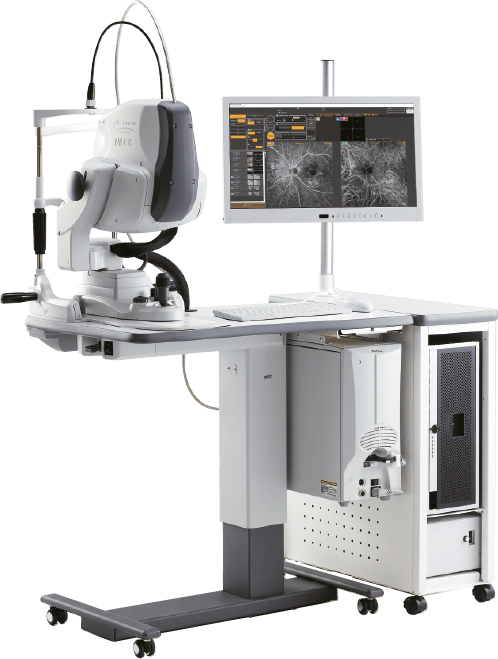
Homepage > Multimodal platforms > Mirante SLO (SLO)
The Mirante SLO model is dedicated to the photography of the fundus. It is a large field multimodal imaging platform. It relates the useful images to the precise analysis of the retina and of the choroid of the anterior pole at the extreme periphery.
The Mirante model SLO collects the entire photographies used daily to observe the fundus. They can also be obtained in ultra large field mode:
The images of the fundus obtained through an LSO scanning and a normal 89° field, and a large field up to 163° are high-definition images, with a premium contrast.
The analysis of colour photos and red, green and blue original images, obtained directly and without a filter from each wavelength-dedicated sensor makes possible viewing the finest details of the fundus to easily detect the lesions arising in retinal-choroidal pathologies.
We use the auto fluorescence to analyse the pigmentary epythelium. There are two versions of auto fluorescence: the green wavelength one to correctly view the macula and the blue wavelength one, more convenient to observe the papilla. Therefore, adapting the reading to the studied pathology is possible.
Dynamic or static injection angiography acquisitions, using fluorescein and/or the ICG, are used to observe the vascularisation of the retina and the choroid, from the early filling phases to the late times. Thanks to the real-time infrared imaging, the alignment is performed at the beginning of the injection, thus reducing the loss of information. The automatic setting of the gain, independent for the fluorescein and the ICG, limits the saturation of the signal that sometimes hind the fundus. You can then confirm your diagnosis using the detection of vascular lesions, such as aneurysms, ischemia and leaks.
The retro mode is a technology specially attached to the Mirante. It is an infrared imaging of the deep layers of retina to highlight the structures of the pigmentary epythelium and of the choroid. It uses, derivatively, the LSO technology, and reinforces the detection of fine lesions on these difficult-to-access layers, particularly the lesions of drusen, the conventional imaging methods cannot sometimes see.
The ultra large field adapter is used to enlarge the analysis zone up to 163°, to access to the periphery. By tilting and rotating the upper part of the product, you can observe the fundus, up to the extreme periphery. The reconstruction of different pictures provides a view of the entire fundus, up to the ora serrata.
The NAVIS-EX software platform can analyse all the data. This interface controls the entire patient database for the NIDEK imaging devices. It is equipped with viewers dedicated to Mirante results.
LSO imaging analyses of the fundus:
These mentions are conforms to the French regulation and may vary depending on circumstances in each country.
Brochure et livret de cas cliniques :
Articles multimodalité :
Retours d’expert
Retours d’expert rétromode :
Présentation de cas
https://retinatoday.com/issues/2022-may-june-insert3
You have a project? You want a quotation? You have questions about our products?
Feel free to ask your technical sales representative.
Reliability and
safety
Technologies and
innovations
Services and
guarantees
KEY PRODUCTS
© 2021 • NIDEK SA – All rights reserved
Ce site est réservé aux professionnels de santé